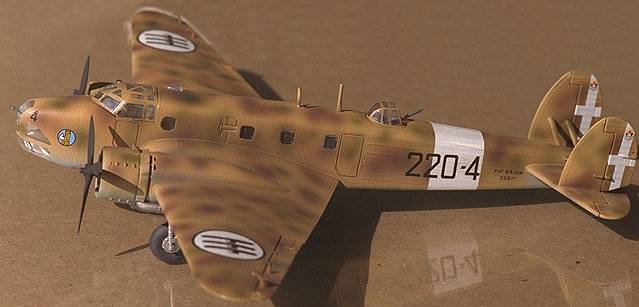
Kit: Fiat BR.20M
Scale: 1/72
Kit Number: 143
Manufacturer: Italeri
Price: $7.50
Media: Injected Plastic
Decals : Three versions: two Reggia Aeronautica and one Japanese
Date of Review: 30 Nov, 1996

Comments: The Fiat BR.20M was Italy's first really successful bomber. Built in relatively large numbers, this twin was successfully exported to Japan in the late 1930's and used in Japan's wars with Russian and China during that period. By the time World War II arrived, it was decidedly a second line aircraft, but fought with some distinction as long as the air defenses were not too strong.
Italeri's kit is molded in light grey plastic with raised detail, including a very large number of scale-appearing rivets. Wing control surfaces are separate which is nice, but they don't fit well unless fixed in a neutral position, which is too bad. The entire nose section is molded in clear plastic which helps as there are many small and unusually shaped windows in the front. Both the nose and dorsal turret can be made to revolve and the underside gun position can be raised or lowered. Overall, the mold is very well done and fit is not much of a problem. The wheel wells are not boxed in and the cockpit is complete but rudimentary. However, considering the vintage of the kit, it was first-rate for the time. Fit was not a big problem although there was need for care and putty when attaching the clear nose section and when cementing the fuselage halves together. One needs to take care that the interior floor is properly aligned or there will be big problems with the fuselage halves. There also needs to be care when gluing the twin tails and their supports, but once the cement has dried, the assembly is very sturdy. All the other assemblies went quite well, the wings in particular needing no putty at the wing/fuselage join, a surprise for me.
Once the kit is completed and masked (a time consuming job due to the myriad of windows), it is time for paint. I chose one of the Italian units as I especially like the mottled paint scheme of these aircraft. The overall airframe was painted Italian Light Grey on the underside and then a sand color was painted on the upper surfaces. This sand color is carried onto the underside of the wings a short distance so must be masked off. Once these colors had dried, it was time for the brown and green mottling. I chose paints that closely matched those in several reference books as Italian standard paints were not available. The over all effect is quite pleasing. Next came the decals after a coat of Future to provide a gloss surface. I used the kit decals, including the white fuselage band, and was pleased with the results. Although the decals are quite flat, they were opaque and responded relatively well to Solvaset. I had almost no problems with silvering and they conformed to most of the rivets. Besides, aftermarket decals for the BR.20 are, as far as I know, nonexistent.
The finished kit adds a lot to my WWII collection and although not currently available, will probably be re-released in the near future. If you are interested in the subject, pick one up the next time it is offered.